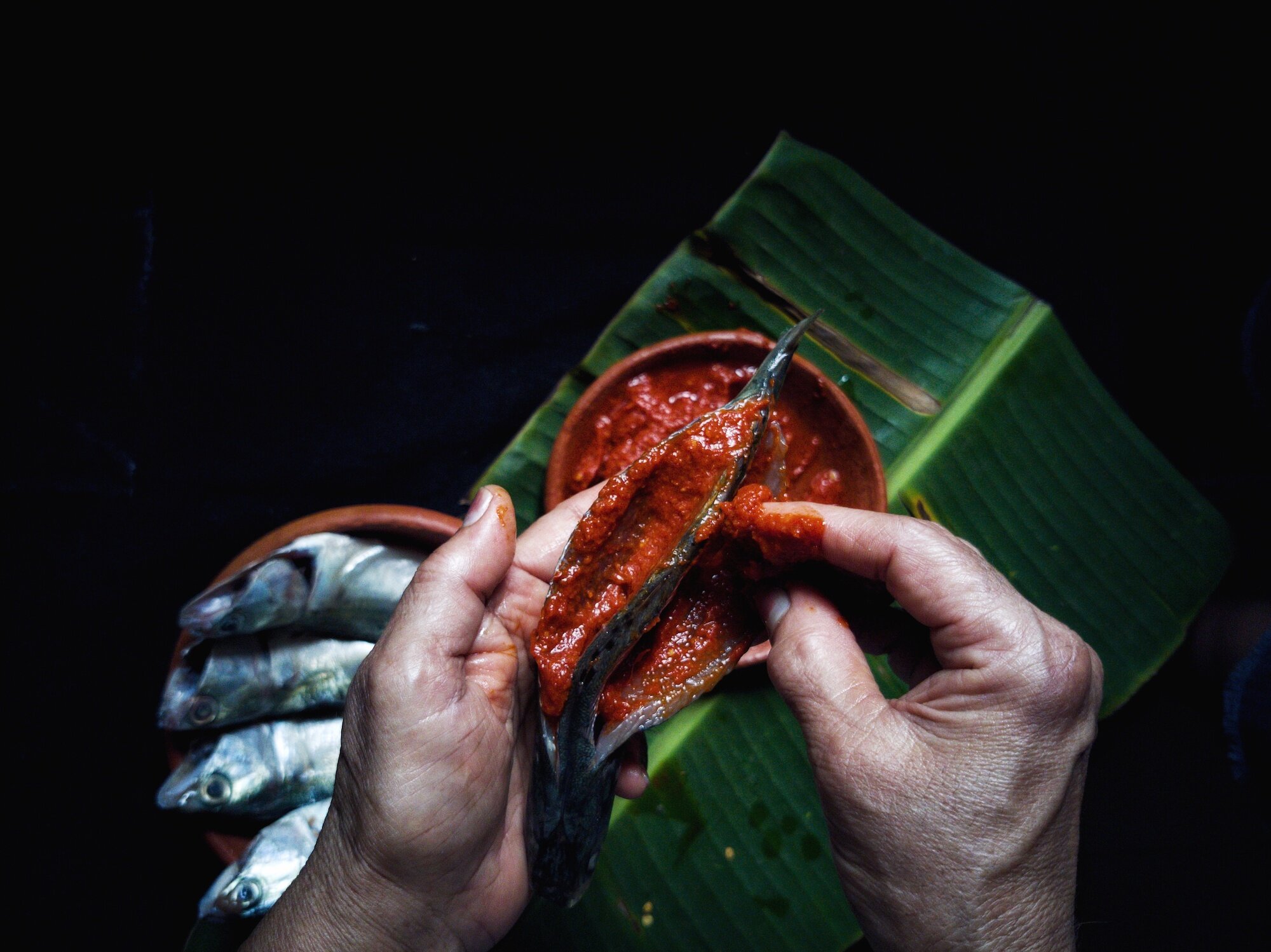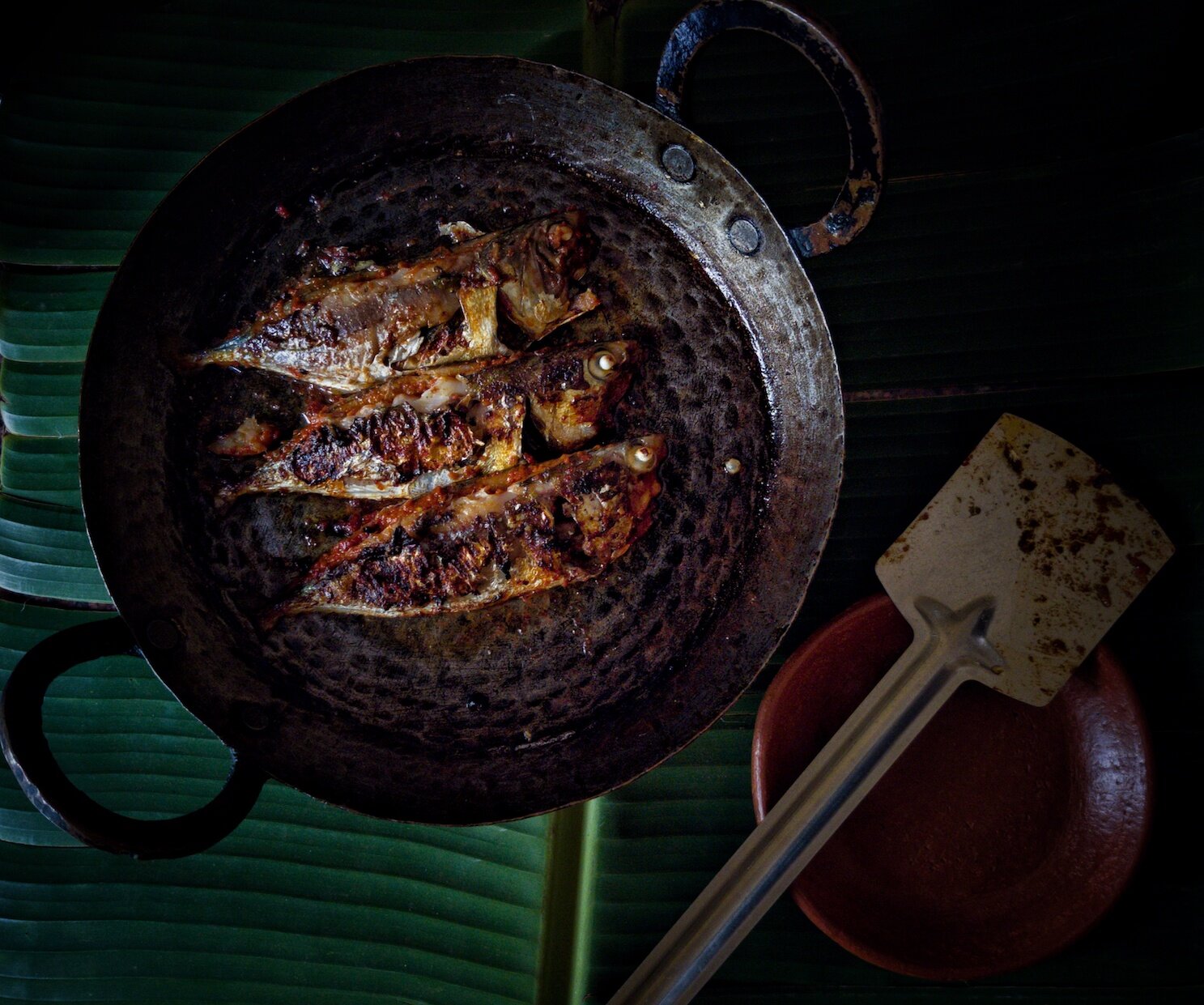Meet Mirsang: At the Heart of the Mangalore Catholic Kitchen

The Mangalorean Catholic kitchen would be incomplete without a bottle of meet-mirsang paste. Although it is used primarily for seafood, its versatility makes it a kitchen all-rounder.
Growing up in the Gulf, I looked forward to the two months of summer vacations in Mangalore. My paternal grandmother, elated to have her family with her, would cook up storms for each meal satisfying every craving, ensuring long, blissful siestas and a few extra kilos on each one of us. Masliche kodi (coconut milk-based fish curry) or bazule masli (fried fish) were lunch staples. Just hearing the sizzle of the fish, as it was being fried, was enough to make me happy. But, what always fascinated me was the luscious red masala that my grandmother would pull out of our light-blue Kelvinator fridge. The fish of the day would be lightly slashed along its length on both sides. A spoon (always the same one) would be used to take a generous helping of the masala out of the bottle. Mai (my grandmother) would use her fingers to scoop the masala off the spoon and apply it generously onto the fish. It was then set aside for around half an hour.
Photo credit Johncie Correia
From the time I was tall enough to hang on to her cotton sari pallu and follow her around, I remember watching her, half perched on the edge of the kitchen platform following this ritual of marinating the fish every afternoon. Just before frying it, she would gently roll the fish in a plate of rava (semolina), and into the pan it would go. The sizzle would send me scurrying for cover, but the aromas would draw me right back. When served, everyone at the table knew why one piece of fish always had a small chunk missing. I always got the first bite, as soon as it was taken off the pan.
One day, Mai applied the masala and turned away to return the bottle to the fridge. Curiosity got the better of me and I swiped a finger-full of the masala off the fish and popped it into my mouth. The red colour fascinated me so. However, seconds later, the chillies that make up the masala, which little me did not anticipate, hit like a freight train. That was my introduction to the meet mirsang (translating to salt-chilli) paste — a staple in every Mangalorean Catholic home.
That Bottle of Meet Mirsang
While I consider myself a good cook, I must confess there are some things I still prefer leaving to my mother. Like making meet mirsang. Sometimes, when I do run out, I am lucky that my mother is also a cookbook author who has documented over 100 traditional Mangalorean recipes in Jane Dsouza’s Cookbook and the recipe is right there for me to follow. I do make the meet mirsang myself occasionally but mom’s hand seems to have some magic of its own.
Photo credit Johncie Correia
Photo credit Johncie Correia
Her recipe is quite simple — a mix of dried chillies, cumin seeds, and salt is ground to a thick, smooth paste in vinegar. While we grind this in a mixer-grinder today, mom has always told me that nothing beats the meet mirsang that is ground on a vaan — the traditional manual stone- grinder. Electric mixers bring in a little heat to the masala as it is being ground, and it can change flavours to some extent. But, with the rhythmic movement of the ghatno (grinding stone), the temperature remains steady and the masala retains all its flavours. It is scooped out with a katti (a clean coconut shell) to avoid any moisture from a spoon or a hand.
While delving deeper into the story of meet mirsang, the use of vinegar was of special interest to me. It seemed too new-age an ingredient to feature in a masala as traditional as the meet mirsang. Speaking to mom and some of my grand-aunts, it was clear that the whole idea was to use something that would act as a preservative to help the masala stay longer. Vinegar fit the bill perfectly. Its use was for times when the mitsef (the Konkani pronunciation of the meat-safe), was the only means of storing food.
While synthetic vinegar is a convenient ingredient today, mom recalls how her mother would buy acetic acid from the market, dilute it and make her meet mirsang with it. While researching, I came across Julie Sahni’s 1987 The New York Times article titled Food, Playing with Fire, which speaks of the meet mirsang being made with wine vinegar. True enough, I believe her reference is to the toddy vinegar — which was extensively used back in the day; toddy essentially being palm wine. Scanning through the traditional Mangalorean cookbooks I often refer to, I found what I was looking for in Isidore Coelho’s The Chef. This book has been gifted to every newly married woman over the last four decades or so. It has seen over 17 reprints.
The book shares a recipe to make toddy vinegar — placing a covered jar of pure toddy in the sun for three weeks and bringing it in every night. The vinegar that forms is strained and used. To add some colour to it, sugar is broiled, tied into a little muslin cloth potli (bundle) and soaked in the vinegar. Such kinds of vinegar can also be made with sugarcane juice and dates. I can only imagine the layers of flavour to a meet mirsang that such varieties of vinegar would bring.
I have also come across a range of ingredients being added to the basic meet mirsang recipe that we use. Some substitute the Byadgi chilli with Kashmiri chilli, bringing in that fiery red colour without the heat. Some others amp up the flavour quotient by adding in peppercorns, whole garlic and ginger. Rock salt is used in place of table salt. Irrespective of how you make your meet mirsang, it’s the simplest way to enhance flavours of core ingredients and give you that typical bouquet of Mangalorean flavours.
Cooking with Meet Mirsang
The meet mirsang is essentially used to marinate fish and fry it. Nothing beats a bangude (mackerel) or a pomplet (pomfret) that is fried with this masala. In our home, we use it as a marinade for other dishes too. Mom tosses a batch of freshly-shelled prawns with a teaspoon of this masala and fries it up. The meet mirsang gets a lovely char when shallow fried and makes a bimbli saar (a watery toor dal gravy with averrhoa bilimbi) and rice meal exceptional. When pathrade (made with shredded colocasia leaves and rice paste that is steamed into blocks) is being sliced for a tea time snack, it is rubbed with some meet mirsang and pan-fried. It makes a great snack for when you are indulging in your favourite tipple over the weekend too. There is also the summer special, deviso guzo (breadfruit) that is sliced, marinated in meet mirsang and pan-fried.
Mom and I both love to experiment in the kitchen and we have come up with our uses of the paste. Mom has used a small teaspoon of it when making lamb mince cutlets. It truly ramps up the flavour. I have found that adding a spoonful to my kheema masala or even to my beef Bolognese sauce gives them both a nice touch. I even created a quick workday chicken curry dish with it. All you need is chicken marinated in a spoonful of meet mirsang, curd, and ginger-garlic paste. Fry some sliced onions/shallots, add in the marinated chicken, cook till done. For another layer of flavour, you can finish off with some thick coconut milk. The versatility of the paste is only limited by your imagination.
Before I let you go off to make your bottle of the paste, I have to tell you about another, lesser-known version of the meet mirsang — one that bears no resemblance to the paste, yet goes by the same name. Why this is so is as much a mystery to me as it may be to you. This is a dip – used alongside fried fish, or simply to add some flavour to perz (rice gruel). In some tamarind water, hand crush some bird’s eye chilli and add in a touch of salt. Dip your meet mirsang coated fried fish into this meet mirsang dip and believe me, you will never want it another way again.
From Jane Dsouza’s Cookbook
Meet Mirsang
(Makes around 200 g of paste)
Ingredients
125 g byadgi chillies
125 g gundu (Salem Gundu) chillies
2 tsp cumin seeds/jeera
5 tsp salt
Vinegar , as needed.
Method
Grind all the ingredients together with splashes of vinegar till it comes together as a thick, coarse paste. Bottle in a clean, sterilised jar. It keeps in the fridge for up to 6 months.
Quick Meet Mirsang
(Makes around 100 g of paste)
Ingredients
100 g red chilli powder
2 tbsp turmeric powder
2 tsp cumin/jeera powder
5 heaped tsp salt
Aprrox. 250-300 ml vinegar
Method
Blend all the ingredients in a mixie till you get a smooth paste. Bottle in a clean, sterilised jar. It keeps in the fridge for up to 6 months.
Note: And an absolute quick fix is to mix some Mangalorean bafat powder with some salt and vinegar to make an instant paste. While it does the job, it does not match up to the real deal.
Photo credit Johncie Correia
Ruth Dsouza Prabhu is an independent features journalist based in Bengaluru, India. She has been writing on food for over a decade. Her work has appeared in Al Jazeera, Reader’s Digest, and Condenast Traveller, among others.
ALSO ON THE GOYA JOURNAL










